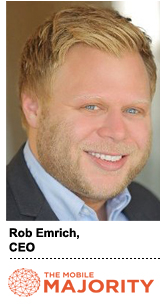 The average tech stack runneth over, but that’s not exactly a good thing.
The average tech stack runneth over, but that’s not exactly a good thing.
According to joint IAB/Winterberry Group research, more than half of marketers use between five and 10 point solutions and roughly 27% of marketers use between 11 and 20 different technologies to manage their programmatic campaigns.
One industry insider quoted in the report, a chief analytics officer at a global media agency, called the situation “a hot mess” – a hot mess that’s setting the industry up for a serious mobile viewability problem, said Rob Emrich, CEO of ad tech startup The Mobile Majority.
“You’re only as good as the weakest vendor you’re working with and a lot depends on how they all interact with each other,” Emrich said. “By the time you’re done making a mobile ad buy, you’ve probably worked with somewhere between five and 15 vendors, give or take. Not to mention that a good portion of your actual budget is going to fees.”
The process between an app opening and an ad serving takes less than half a second, but there’s still ample opportunity for the process to break down, Emrich said, noting that creative should also have a seat at the programmatic table.
“You might have beautiful, tested, optimized creative, but if you’ve got a fraud problem, you’ll have bad results,” he said. “Or, let’s say you solve your fraud problem, but all you have are static images with no option for rich media or video. You’re still probably not going to get very good results.”
The Mobile Majority has about 50 employees spread across offices in Los Angeles, San Francisco, New York, São Paulo, Bogota and Chicago, with sales offices in Detroit and Columbus, Ohio. The company, whose client list includes Paramount Pictures, Scholastic, NFL, FIFA, NBC and Expedia, ran just shy of 200 campaigns in 2014.
AdExchanger caught up with Emrich.
 AdExchanger: How would you describe The Mobile Majority?
AdExchanger: How would you describe The Mobile Majority?
ROB EMRICH: We’re a vertically integrated DSP with all the elements necessary to run mobile ad campaigns in one place, including our AdKit tool, which helps developers build rich media ads, ensures that ads render properly and runs analytics.
But we started life as a rewards network for mobile apps called PaeDae [in 2012]. We had an SDK and we sold advertising, a very common approach to mobile advertising. When our company started to get scale, we needed to buy outside of our publisher network, so we started using a rich media builder from a company whose name I don’t want to smear – but when we did that, our engagement rates plummeted from about 3% or 4% to .001%.
That was a big problem for us because we were a performance business. As a company, we were fighting for our lives. We just couldn’t scale the supply side fast enough, but we weren’t sure what we were doing wrong.
What did you do next?
Last year, we systematically went through every step necessary to traffic ads at scale across the entire mobile ad tech ecosystem. And then we decided to build our own holistic technology. We built AdKit so we could start treating ads like apps. Ads are no longer just images, they’re software and we need to treat them like software and measure them like software.
We don’t go through intermediaries in order to buy impressions. We bid directly with the exchanges and the ad networks. We also go out and negotiate preferred pricing with certain vendors. The idea is to build an integrated platform, rather than piecemeal solutions that are cobbled together. Otherwise, programmatic breaks down.
We no longer have an SDK and we’re not a network. We don’t maintain active relationships with publishers and developers like an ad network does.
Why not?
Because ad networks often end up having to talk out of both sides of their mouth, promising the highest CPMs to publishers and developers and the lowest CPMs to advertisers. We made the decision to represent the buy side only.
We’re trying to simply eliminate the ads that won’t get results, versus a company that gets paid to serve ads, which means they’re motivated to serve lots of ads whether or not they’ll be seen by a real person.
We don’t have that inherent conflict of interest. But, of course, there will be inherent issues with scale.
What’s your stance on mobile viewability?
Mobile viewability isn’t just about the fraud component. It’s actually a much larger problem that revolves around creating software and technology that works together. There is a persistent lack of disintermediation between all of the different tech vendors out there that’s helped create a large part of the viewability problem.
There’s been a breakdown in the process. These technologies aren’t generally designed to work together and are owned by companies that don’t have any incentive to work together to get it right. When an advertiser works with multiple vendors and they’re calling APIs from all over the world, there isn’t always enough time to tell the difference between an ad that was served and an ad that was viewed.
The industry has viewability on the brain right now in a serious way. Is enough attention being paid to mobile viewability, specifically?
When you talk to media buyers, some of them still think of viewability as a box to check. And if they’re not sure how to approach mobile, it’s easy enough for them to just tell Facebook or Google to put 15% of their ads towards mobile – and done.
Any company today can say, “Yeah, we do viewability,” but that doesn’t really mean anything. The way most companies are set up, they’re not in a position to deal with viewability because they don’t control enough of the technology.
Can you share a recent client example?
We worked with Paramount to promote “Transformers 4.” Users could watch the movie trailer for a chance to win a trip to New York City and tickets to the premiere. Sixteen percent of people clicked to play the video, and of those 90% finished viewing the video voluntarily. It was not a mandatory pre-roll. Of that group, 11% entered the sweepstakes and 7% clicked to add the movie release date to their calendars.
Creative advertisers can get more out of mobile. The add-to-calendar option was a quick and easy action for the user that almost guaranteed some form of follow-up or attention in the future. This is a real person’s calendar we’re talking about, which has implications in terms of viewability. We focus on real people.
Speaking of real people, is mobile fraud a real problem yet? Most pundits seem to predict an uptick in mobile fraud when ad spend reaches a level commensurate with consumption.
It’s coming. There’s a huge delta when it comes to mobile. That’s well known. What’s not so well known is why.
It’s the chicken and the egg problem. Is there no spend because there are no great solutions or are there no great solutions because there’s no spend?
Industry reports have predicted that ad fraud left unchecked could cost advertisers more than $6 billion in 2015. How much of that do you think could be attributed to mobile?
I wouldn’t be able to say for sure, but I can say than when we look at some of the inventory out there, we see rates of non-viewable ads as high as 80% and sometimes even higher.
What do you think about the existing fraud standards?
The 50% in-view standard doesn’t include rich media and most ads today have rich media or JavaScript running. There’s also this crazy assumption that viewability on the mobile web will also work in-app, but in-app is way more complicated than the mobile web.













